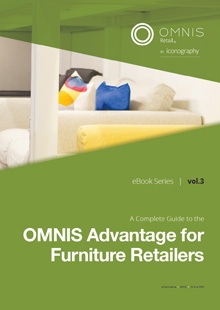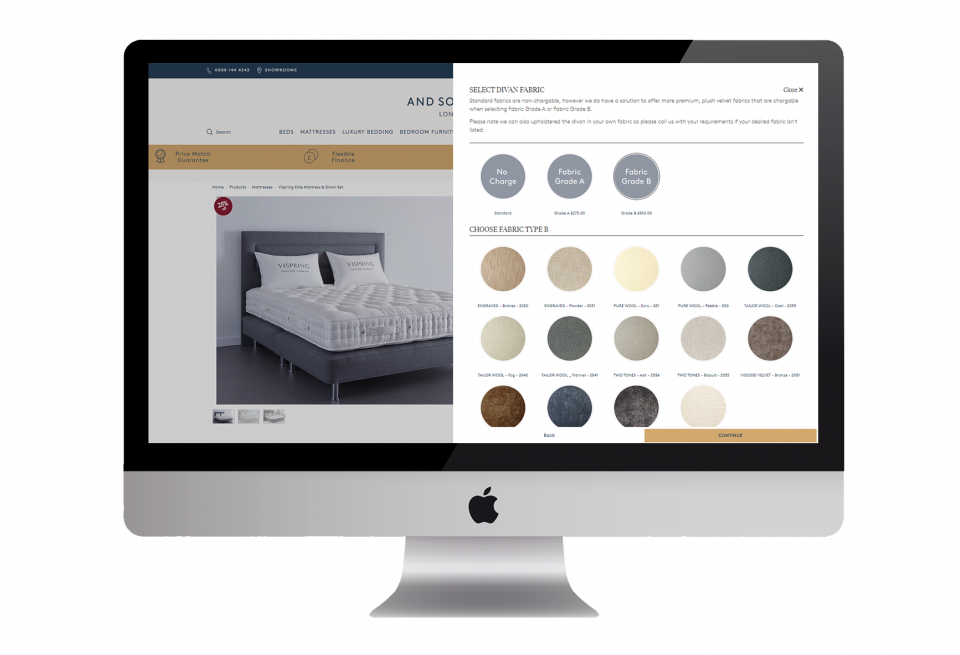5 tech solutions helping furniture retailers to sell more
Need a modern retail platform?
The lines between shopping online and instore are becoming increasingly blurred. Furniture retail is one sector where the gap is closing increasingly quickly. It’s now commonplace for a customer to browse online, head to a store to see the product in person and go home to buy online from the retailer, or wherever they can find the cheapest price. Furniture retailers must keep in touch with the shopper at every touchpoint or risk losing out to those that do.
One way to engage shoppers across online and offline touchpoints is to implement relevant technology. Doing so will help retailers to better understand the customer journey and increase loyalty leading to repeat purchases and increased order values. With many retailers now implementing new tech to stay ahead of the curve, which of these 5 technologies are you using to bridge the gap and stay relevant in the eyes of the customer?
Retail by Iconography
Did you know that our Unified Commerce platform mixes eCommerce, RMS, CRM and EPoS?
OMNIS Retail is an award winning platform with a single database handling customer data, stock management, purchase ordering and much more.
Too many furniture retailers are being held back by out of date software
Mobile devices on the shop floor
It’s surprising how many retailers still haven’t equipped shop floor staff with simple handheld technology like a tablet or mobile device. Doing so can revolutionise the instore customer experience. From advising customers on real-time stock levels to providing detailed, consistent product information to using devices as a remote till to check customers out anywhere in the store, mobile devices are a simple yet underused resource in retail.
For furniture retailers mobile devices on the shop floor go a long way to helping resolve the age-old issue of limited shop floor space. With the right backend system in place, furniture retailers gain the advantage of being able to show a far-extended range of products from the comfort of their own store, commonly referred to as an ‘Endless Aisle’.
Endless Aisle harmonises online and offline shopping by allowing customers to browse a full product catalogue while on the shop floor. Potentially this means showcasing hundreds more products than are displayed in the store as well as bespoke and made to order items.
The opportunities for upsells and cross-sells increases dramatically and suddenly the customer is sitting in a retailers store browsing for products online with the help of a shop assistant rather than at home with a barrage of intrusive adverts and distractions.

A complete guide to removing headaches
Get the OMNIS advantage for furniture retailers
Augmented reality embedded into buying experiences
For retailers already using mobile devices on the shop floor, the opportunity for innovating the instore Endless Aisle and online experience is increased thanks to affordable and brandable Augmented Reality (AR) solutions.
One of the biggest success stories within the furniture industry is Ikea who developed their own AR app. IKEA Place allows customers to see what certain products look like around their home using the camera on their mobile device. Should they like the product customers can purchase the product directly, in-app.
Another example of bringing a store into the customers home is the ‘Dulux Visualizer App’. This innovative and clever app enables customers to try different paint colours at home using their smartphone camera. After choosing a colour the app overlays it directly onto their wall of choice. Suddenly there’s no need to buy sample pots or take the risk of buying tins of paint that might not be quite right.
For furniture retailers working with tight budgets and/or extensive product lines creating 3D models of hundreds of products may seem like a lengthy task with the risk of little return. However, many retailers will already be running photoshoots for their online catalogues so taking a few additional photos that can be turned into 3D models may not be as time-consuming and costly as one may think.
Creating an Endless Aisle of 3D images viewable in AR seems like a much better way for the customer to interact with products than a flat 2D photo. Plus, if furniture retailers can incorporate this tech into their online experiences shoppers can place products they’ve seen instore, within their home environment adding to the overall brand experience and increasing the chances of winning their business.
Artificial intelligence to deliver truly personalised experiences
So far we’ve looked at tech that can enhance the instore shopping experience. Now we’re going to look at what retailers can do when it comes to optimising their eCommerce channel.
When it comes to shopping online, customers no longer want a highly personalised experience, they expect it and the retailers that can deliver are likely to win big. A recent study of 1000 consumers found that forty-four percent said they would repeat purchase after experiencing the benefits of a personalised shopping experience. This finding alone is enough to suggest that eCommerce personalisation is worth the investment.
In reality delivering personalisation online isn’t easy, especially for those using off the shelf eCommerce solutions like Shopify and Magento. Features such as personalised banners based on browsing history, auto-sorting products based on what similar customers viewed and personalised product recommendations can’t be implemented quickly or cheaply and are best delivered by eCommerce experts that have built platforms to deliver such experiences.
For retailers committed to getting ahead and offering a level of personalisation that the customer expects replatforming should be a serious consideration. But, personalisation does not stop there. Adverts, emails and direct mail communications should all be tailored to where the customer is in the buying journey, pre and post-purchase. Delivering this type of experience relies on retailers having a unified system that captures data across all channels and makes it accessible wherever and whenever it’s needed.
Use technology to drive customer experience and encourage loyalty
Email automation to increase loyalty and drive repeat business
In the same way that a website experience must be personalised retailers should be using email automation technology to engage with potential and existing customers to drive sales, loyalty and repeat business.
The key to successful email automation is delivering the right content at the right time. A blanket newsletter will no longer deliver a flood of customers wanting to make a purchase. Those that are not yet customers, but that have signed up for email updates, want inspirational content that gently nudges them towards making that sofa purchase or buying that dining table. The odd discount might help too.
On the other hand, existing customers want to feel that retailers still care and that they haven't been forgotten now they've handed over their money. Flash sales, exclusive customer events, personalised product recommendations and even personal discounts on birthdays and anniversaries are all great ways to use email automation to drive purchases and increase loyalty.
To be effective an email platform needs to be closely aligned with a Customer Relationship Management platform (CRM). A CRM captures and records customer data, sometimes even segmenting and sorting it too. This data is then delivered to the email automation platform which delivers the email communications and records whether customers open or ignore it. Creating the right workflows or series of emails will help to nudge the customer along their purchase journey until they are ready to make a purchase.
Connect online and offline with Unified Commerce
It’s well documented now that for many purchases, not just furniture, the customer journey takes place online and offline and isn’t a linear process. A trip to a retail park at the weekend might lead to further online research, an online purchase, or a trip back to a store to buy in person. Because of this retailers must have a system in place to identify the customer across all touchpoints so they can pick up where they left off.
A perfect example of this being done well are retailers using a unified commerce platform. (A unified commerce platform is an all-in-one solution that centralises essential retail information such as inventory, product information and customer data as well as acting as EPoS and eCommerce channels).
Using a platform that incorporates these essential retail systems allows the retailer to gain a single view of the customer and deliver a true omnichannel experience. In reality, this means building quotes that the customer can retrieve and complete online, allowing the customer to check stock in their closest store and giving them access to the same level of product information at home that they were being given on the shop floor. The customer is therefore never detached from the instore or online experience and can shop as they please without distraction and limitations.
Being able to deliver this fluid and cohesive experience is the goal of many multichannel retailers who still operate with siloed legacy systems that simply don’t bridge the online/offline divide. To evolve from a multichannel retailer to an omnichannel leader requires implementing a system that puts the customer first and that makes critical retail information accessible in real-time to every customer and internal stakeholders whenever they need it.
OMNIS Retail for furniture stores
The way that customers shop is always evolving and so to stay relevant and meet demand retailers must react by implementing technology and processes that deliver on the customer’s expectations of a modern retailer.
It’s no longer enough to have a shop, a website and to be on social media. The shopping experience needs to be connected, fluid, coherent and engaging whether that’s online or offline. The way that retailers can adhere to the customer’s demands is to recognise the power that even the simplest technology has to keep them relevant in the eyes of the customer.
OMNIS was born out of the needs of a leading direct to consumer brand who wanted to remove the limitations, constraints and operational inefficiencies associated with integrating an eCommerce website with offline EPoS and legacy back office retail software.
We quickly saw the vast potential OMNIS possessed. It’s a need we’ve recognised with many other retailers and DTC brands that have similar aspirations and want to remove the restrictions of old retail technology and software.
In OMNIS you can create multiple warehouses with any number of locations, place purchase orders and complete stock transfers. We have a full range of reporting and administrative control suite. Together, these give you complete control and oversight over your stock across all channels.
Would you like to know more?

Online and instore retail
OMNIS Retail is a pioneering new retail solution that has been driven by D2C brands & niche retailers looking to the future. A single database eliminates any data integration issues between outdated systems, instead providing a cloud-based omnicommerce retail solution fit for the 21st century.
It’s one system that constantly mirrors across the whole business, which is a massive positive
Jade Farthing, Haskins Furniture
Get in Touch